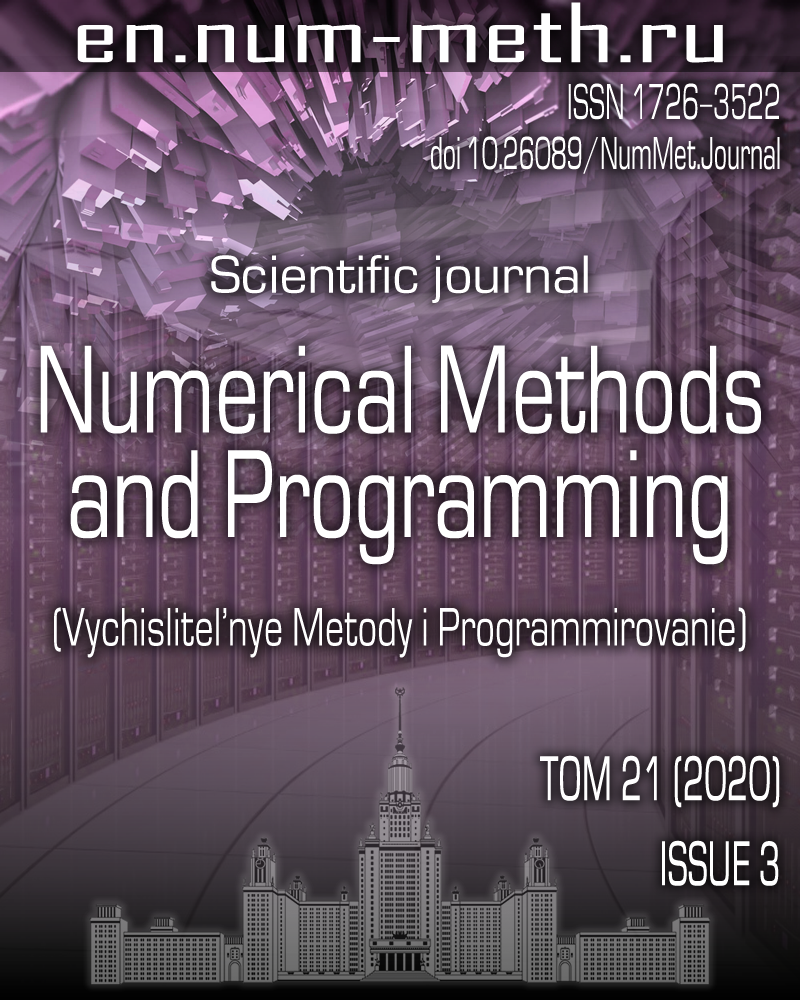DOI: https://doi.org/10.26089/NumMet.v21r318
Parallel algorithms for solving the problem of coastal bottom relief dynamics
Keywords:
Abstract
A nonstationary 2D model of bottom sediment transport in the coastal zones of shallow water reservoirs is supplemented with the Navier–Stokes equations, the continuity equation, and the state equation of the water environment. A discrete model of sediment transport is obtained by approximating the corresponding linearized continuous model. Since the problems of predicting sediment transport need to be solved in real or accelerated time scales, parallel algorithms for hydrodynamic problems on systems with mass parallelism should be developed on grids with 106–109 nodes. The paper contains the results obtained by an efficient software implemented to perform hydrodynamic computational experiments that allow the numerical modeling of bottom deformation in the coastal zones of reservoir. The results of numerical experiments are discussed.
Published
Issue
Section
References
- G. I. Marchuk, V. P. Dymnikov, and V. B. Zalesny, Mathematical Models in Geophysical Hydrodynamics and Numerical Methods for Their Implementation (Gidrometeoizdat, Leningrad, 1987) [in Russian].
- R. A. Callander, “Instability and River Channels,” J. Fluid Mech. 36 (3), 465-480 (1969).
- S. Ikeda, G. Parker, and K. Sawai, “Bend Theory of River Meanders. Part 1. Linear Development,” J. Fluid Mech. 112, 363-377 (1981).
- G. Gic-Grusza and A. Dudkowska, “Numerical Modeling of Hydrodynamics and Sediment Transport - an Integrated Approach,” Ocean Dyn. 67, 1283-1292 (2017).
- X. Liu, S. Qi, Y. Huang, et al., “Predictive Modeling in Sediment Transportation across Multiple Spatial Scales in the Jialing River Basin of China,” Int. J. Sediment Res. 30 (3), 250-255 (2015).
- M. Ouda and E. A. Toorman, “Development of a New Multiphase Sediment Transport Model for Free Surface Flows, Int. J. Multiphase Flow 117, 81-102 (2019).
- H. Aksoy and M. L. Levent Kavvas, “A Review of Hillslope and Watershed Scale Erosion and Sediment Transport Models,” Catena 64 (2-3), 247-271 (2005).
- K. A. Podgornyi and A. V. Leonov, “Modelling of Suspended Matter Distribution in Marine Coastal Areas: 1. Description of the SM-model,” Okeanologich. Issled. 45 (1), 109-141 (2017).
- A. Ashton, A. B. Murray, and O. Arnoult, “Formation of Coastline Features by Large-Scale Instabilities Induced by High-Angle Waves,” Nature 414, 296-300 (2001).
- T. J. Andersen, M. Pejrup, and A. A. Nielsen, “Long-Term and High-Resolution Measurements of Bed Level Changes in a Temperate, Microtidal Coastal Lagoon,” Marine Geol. 226 (1-2), 115-125 (2006).
- T. Francke, J. A. López-Tarazón, D. Vericat, et al., “Flood-Based Analysis of High-Magnitude Sediment Transport Using a Non-Parametric Method,” Earth Surf. Process. Landf. 33 (13), 2064-2077 (2008).
- A. I. Sukhinov and A. A. Sukhinov, “Reconstruction of 2001 Ecological Disaster in the Azov Sea on the Basis of Precise Hydrophysics Models,” in Parallel Computational Fluid Dynamics 2004: Multidisciplinary Applications (Elsevier, Amsterdam, 2005), pp. 231-238.
- L. Amoudry, A Review on Coastal Sediment Transport Modelling , POL Internal Document No. 189 (Proudman Oceanographic Lab., Liverpool, 2008).
- A. I. Sukhinov, A. E. Chistyakov, and E. V. Alekseenko, “Numerical Realization of Three-Dimensional Model of Hydrodynamics for Shallow Water Basins on High-Performance System,” Mat. Model. 23 (3), 3-21 (2011) [Math. Models Comput. Simul. 3 (5), 562-574 (2011)].
- A. I. Sukhinov, “Precise Hydrodynamic Models and Their Applications to the Prediction and Reconstruction of Emergency Situations in the Sea of Azov,” Izv. Taganrog Radiotekh. Univ., No. 3, 228-235 (2006).
- A. V. Nikitina, A. I. Sukhinov, G. A. Ugolnitsky, et al., “Optimal Control of Sustainable Development in Biological Rehabilitation of the Azov Sea,” Mat. Model. 28 (7), 96-106 (2016) [Math. Models Comput. Simul. 9 (1), 101-107 (2017)].
- A. I. Sukhinov, E. A. Protsenko, A. E. Chistyakov, and S. A. Shreter, “Comparison of Computational Efficiency of Explicit and Implicit Schemes for the Sediment Transport Problem in Coastal Zones,” Vychisl. Metody Programm. 16, 328-338 (2015).
- A. I. Sukhinov, A. E. Chistyakov, and V. V. Sidoryakina, “Parallel Solution of Sediment and Suspension Transportation Problems on the Basis of Explicit Schemes,” in Communications in Computer and Information Science (Springer, Cham, 2018), Vol. 910, pp. 306-321.
- V. V. Sidoryakina and A. I. Sukhinov, “Well-Posedness Analysis and Numerical Implementation of a Linearized Two-Dimensional Bottom Sediment Transport Problem,” Zh. Vychisl. Mat. Mat. Fiz. 57 (6), 985-1002 (2017) [Comput. Math. Math. Phys. 57 (6), 978-994 (2017)].
- A. I. Sukhinov and V. V. Sidoryakina, “Convergence of Linearized Sequence Tasks to the Nonlinear Sediment Transport Task Solution,” Mat. Model. 29 (11), 19-39 (2017).
- I. O. Leontiev, Coastal Dynamics: Waves, Currents and Sediments Drifts (GEOS, Moscow, 2001) [in Russian].
- A. A. Samarskii and P. N. Vabishchevich, Numerical Methods for Solving Convection-Diffusion Problems (Editorial, Moscow, 2004) [in Russian].
- A. I. Sukhinov, A. E. Chistyakov, and A. V. Shishenya, “Error Estimate for Diffusion Equations Solved by Schemes with Weights,” Mat. Model. 25 (11), 53-64 (2013) [Math. Models Comput. Simul. 6 (3), 324-331 (2014)].
License
Copyright (c) 2020 Numerical methods and programming

This work is licensed under a Creative Commons Attribution 4.0 International License.


